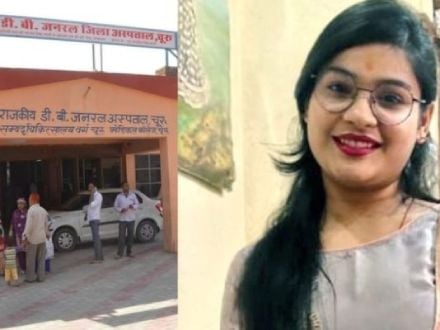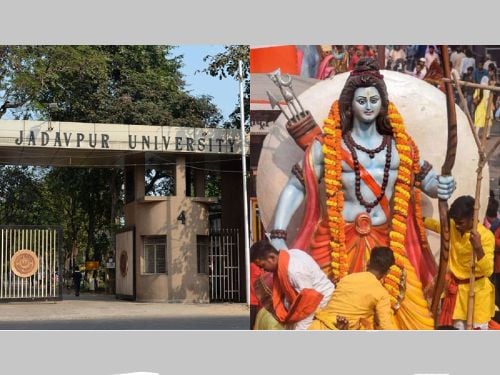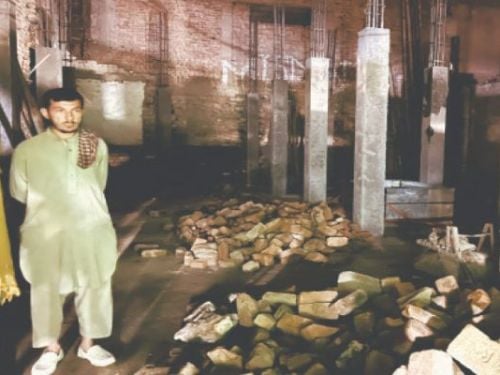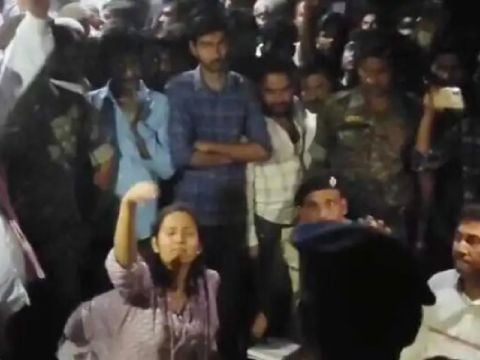Pousha Krushna paksha Chaturdashi, Kaliyug Varsh 5116
The “all religions are equal” syndrome amongst Hindus – Rajesh Patel

Please, Hindus, don’t say, “All religions are the same” – Maria Wirth
_______________________________________________________________________
The first Evangelists who set foot in India undertook a painstaking process of studying every single aspect of the Hindu society and identified practices, traditions, heritage, heroes, languages, grammar, laws, epics, prose, poetry, puppetry, sculpture, art, painting, dance, and drama that glued it together. And then they developed elaborate strategies to unglue the Hindu society. These strategies were multi-pronged, ranging from outright abuse of Hindu gods and goddesses, modes of worship, practices etc, to showing that their “roots” actually lay in Christianity.
As we see today, they have succeeded beyond their wildest dreams !

That the Christian Church has been one of the foreign policy arms of Western powers since the colonial era is a given. As we witness geopolitical developments around the world today, we notice that this selfsame policy has remained unchanged. From denying the US visa to the then Gujarat Chief Minister Narendra Modi to triggering protests against developmental and nuclear energy projects in India, the global Christian network continues to wreak havoc across the world from Africa to Asia.
Including India
With unlimited funds at its disposal and both covert and overt support of powerful Western Governments, the global Evangelical industry uses every trick in the book to subvert regimes and cause irreparable damage to societies. And it is this last point that needs urgent attention as far as India is concerned.
As we see over the last six decades, perfectly harmonious social equations have been violently disrupted the moment missionaries have succeeded in weaning away enough numbers into the Christian fold. The Rwandan genocide is the best example of this in recent times. The present condition of almost the entire North East is another classic case. Odisha continues to boil under Church-sponsored and engineered social disruptions. Andhra Pradesh and Tamil Nadu seem all set to follow Odisha’s lead.
Introduction to Atrocity or Outrage Literature
One of the more effective techniques that the global Evangelical nexus adopts to push its agenda both on the global and local stages is to generate what is known as Atrocity or Outrage Literature.
Atrocity or Outrage Literature can be defined as material – including written, audio and video – produced by the global Christian network that highlights and exaggerates historical, social, political, ideological and other fault lines in non-Christian societies with the deliberate aims to show how :
• These societies are backward, regressive and in a state of perpetual internal conflict.
• Only Christianity has the means and equipment to end such conflict and rescue these societies.
• There is a need for political intervention from powerful White-Christian Western countries to aid the work of these Evangelicals.
The first and only aim of Atrocity or Outrage literature is to completely Christianize non-Christian nations. Both missionary activities on the ground and the generation of atrocity literature go hand in hand. In a way, atrocity literature is both a subset of and a companion to hard core evangelical literature.
History of Atrocity Literature
To be sure, Atrocity or Outrage Literature isn’t a new phenomenon. It has a history of nearly four hundred years in India and elsewhere as we shall see.

The first Evangelists who set foot in India undertook a painstaking process of studying every single aspect of the Hindu society and identified practices, traditions, heritage, heroes, languages, grammar, laws, epics, prose, poetry, puppetry, sculpture, art, painting, dance, and drama that glued it together. And then they developed elaborate strategies to unglue the Hindu society. These strategies were multi-pronged, ranging from outright abuse of Hindu gods and goddesses, modes of worship, practices etc, to showing that their “roots” actually lay in Christianity. As we see today, they have succeeded
beyond their wildest dreams.
Today, the average Hindu is woefully ill-informed and/or ignorant about almost every aspect of his/her own religion and there is no dearth of well-meaning Hindus who subscribe to the “all religions are equal” screed.
Nehruvianism as a destructive force
Even worse, the post-Independence political and economic policies of India has opened up the entire Hindu society as a vast and fertile field for Christian conversions. The blame for this singularly lies at the doorstep of the double-blow that Jawaharlal Nehru dealt to Hindu society : his state policy was designed to place Hindus at a disadvantage in religious, legal and social domains given his advertised disdain for Hinduism. His economic policies impoverished millions of Hindus who, faced with a hunger crisis, converted to Christianity which was open about bribing destitute Hindus with money, education and healthcare in exchange. Thus, Swami Vivekananda’s words that “you cannot preach philosophy to an empty stomach” strikes us as extraordinarily clairvoyant when we recall them now. The same clairvoyance was also reflected in his brutally honest as well shall see at the end of this essay :
“[Hindus] shall otherwise decrease in numbers. When the Mohammedans first came, we are said – I think on the authority of Ferishta, the oldest Mohammedan historian – to have been six hundred millions of Hindus. Now we are about two hundred millions. And then every man going out of the Hindu pale is not only a man less, but an enemy the more.” [Prabhuddha Bharata April 1899]
Colonial discourse on India as an enduring success
One of the earliest and enduring successes of atrocity literature remains in the domain of caste. It has now become an article of faith to blame almost every negative aspect and/or problems of Hindu society on caste, specifically Brahmins.
For example, the All India Christian Council (AICC), which often allies itself with Dalit Freedom Network (DFN) – an organization run by White Evangelical Christians – produces a distorted version of India’s so-called caste system and exaggerates caste atrocities. The recent “success” of the DFN is the successful passage of the anti-caste legislation in the British Parliament. And this legislation is derived directly from the same colonial narrative on caste. And a key member of the AICC is John Dayal who has a history of working against India.

The other domain that the Evangelical machinery has successfully exploited happens to be the status of Hindu women. The early days of colonialism witnessed narratives of how the socio-religious practices of the natives like idol-worship and nature worship were identified with Satanism which victimised women and children. Ananda Kentish Coomaraswamy’s powerful rebuttals – most notably, in his Status of Indian women and Indian images with many arms – highlight the mischiefs in this Church-inspired narrative. Equally, Veena Oldenberg’s book Dowry Murder gives detailed instances of British officials encouraging Indians to narrate dowry cases in an exaggerated fashion in order to pin the blame on the native culture. Today’s aggressive feminist literature and laws unjustly favouring women are direct holdovers of this narrative.
Common characteristics
More fundamentally, the Church-inspired atrocity literature against non-Christian cultures in the world from the early days of colonialism share a few common characteristics :
• In the early days of colonialism, around the 17th and 18th Century, the European settlers portrayed the natives of the Americas, Africa and Asia as primitive savages who needed to be civilised by God-fearing Christians.
• All conflicts between colonisers and natives were presented as clashes between native barbarism and civilised Christians. This narrative justified the brutalities inflicted upon the colonised natives.
• These narratives eventually went mainstream and justified racist theories like the Aryan Invasion Theory and the White Man’s Burden. These theories were therefore taken as the justification for their own colonialism because they were “saving” the oppressed Dravidians from the Aryans.
• While the oppressed natives were shown as barbaric, the Western colonisers saw their own ills like racism, misogyny, and slavery as incongruities that can be corrected.
Much later, when the mirror was shown to the justifiers of colonialism, they mounted their defence in the form of whitewashing colonial brutalities – racism, misogyny and slavery – as mere “incongruities that can be corrected” while continuing to uphold the Church-inspired discourse on Dalits and tribals.
Dalit discourse Christianized
The selfsame DFN and AICC in many instances, use the Aryan-Dravidian clash to paint a gruesome picture of Dalits being brutalised in India by the descendants of the Aryans. One of the leading proponents of this variety is Kancha Ilaiah who believes that India is a fascist state which tortures its Dalit constituents. Other proponents include Angana Chaterji, Gail Omvedt, V.T. Rajashekhar and Vijay Prashad. Such is the pervasive influence of this poisonous discourse that based on the DFN’s propaganda, US Congressman Edolphus Towns identified India as a theocratic tyranny.
Indeed, over at least four hundred years, atrocity literature has found its way even to fiction, plays and films. The theme of academic theories such as the White Man’s burden have been portrayed in these genres as showing that colonized countries were grateful to the colonisers for civilizing them.
Atrocity literature is one-sided
Atrocity literature is one-sided without exception in all cases. In every single case, it ignores missionary conversion attempts which lead to conflict when they are met with resistance from the local Hindu population but only acts of Hindu resistance – which sometimes lead to violence – are reported across international media and other forums as acts of Hindu fascism, and state-sponsored violence against hapless Christians.
Perhaps the best (or worst) representative example of this sub-genre of atrocity literature which was disseminated widely across the globe is in the aftermath of the 80-year old Swami Lakshmananda’s brutal murder in Kandhamal, Odisha. He was gunned down by Maoists at the behest of Evangelicals but Hindus were blamed both in the Indian and international media as committing atrocities against Christians in Odisha.

Today, a mini-sub-genre of the same atrocity literature is emerging in the form of denunciations against ghar wapsi (homecoming) initiated by many Hindu groups engaged in reconversion attempts of their Hindu bretheren who were converted to Christianity or Islam by force or fraud or both.
Gujarat riots cottage industry as national security threat
If the Kandhamal discourse is representative of one type of atrocity literature, there’s yet another and bigger representative : the discourse on the 2002 Gujarat riots.
This discourse gave birth to a phenomenon for which the noted columnist Rajeev Srinivasan coined a new term : the Gujarat Riots Cottage Industry. Indeed, there was no columnist, academician, analyst, author, media outlet, filmmaker, playwright, psychoanalyst, poet, activist, NGO, Mullah, and Evangelist who was not a member of this cottage industry – or who did not profit from it.
To be sure, this industry was centred exclusively on demonising exactly one man : the current Prime Minister of India. The international seminar and lecture circuit was deluged by precisely these Indian suppliers of atrocity literature to the West. Among other things, such concerted efforts resulted in getting the US to deny a visa to Narendra Modi, then the Chief Minister of Gujarat.

During that period, the French scholar Christophe Jafferlot was instrumental in providing significant amounts of atrocity literature about the 2002 Gujarat riots, which then flooded the Western media. Even worse, some prominent members from the Indian Christian lobby and its affiliates – Indian citizens to be sure – testified against a constitutionally elected Chief Minister on foreign soil, before the USCIRF. Members of this lobby include – but are not limited to – John Dayal, Father Cedric Prakash, Teesta Setalvad, Kamal Mitra Chenoy, and John Prabhudoss. If this was not enough, in 2013, 65 Members of the Indian Parliament wrote to Barack Obama to maintain status quo on Narendra Modi’s visa to the US. indeed, the 2002 Gujarat riots discourse demonstrated with frightening aplomb the casual disregard for Indian sovereignty, the scary power of and the threat the Christian lobby poses for national security.
Indian vendors of atrocity literature
This then brings us to yet another dangerous aspect of atrocity literature in the present day – Indian Christian (and other) groups who regularly supply material for atrocity literature to their sponsors in the West.
Again, the AICC acts as the Indian arm of the said global Evangelical network. Even more worrying is the fact that US-based mainstream think-tanks with enormous political clout use these inputs from India to fashion the US government’s India policy. Among others, these are the notable right-wing think-tanks : The Policy Institute for Religion and State (PIFRAS), Federation of Indian Christians of North America (FIACONA), Freedom House, Asia Society (New York), RAND Corporation (which characterizes the RSS as the Hindu equivalent of Al Qaeda), and The Ethics and Public Policy Center (EPPC).
Conclusion
And so the deadly and tragic history of atrocity literature which when it began, was produced exclusively by the missionaries (and used effectively by the colonial British administration), stands transformed thus today :
• It is produced in copious amounts by foreigners directly and indirectly working for or on behalf of the worldwide Evangelical machinery.
• It is produced equally in copious amounts by Indian Christians – both neo-converts and otherwise – who are Indian citizens living in India and abroad, some even working in Government and government-funded institutions, and some working actively in the pay of Evangelical organizations/NGOs of various hues.
• It is produced by Hindus – even by well-meaning Hindus – who are working in NGOs, educational institutions and other charitable/service organizations which are fronts for Evangelical work.
• It is also disseminated by Hindu organizations and media outlets which make apologies for and whitewash even genuine instances of Church brutalities and the widespread phenomenon of child abuse in the Church – all for the sake of career prospects, money, fame, influence and similar considerations.
In the end, we need to call out atrocity literature for what it really is : a determined, focussed and premeditated atrocity against India’s civilizational ethos, which is Hindu first and last. As history is witness, attempts to paint it otherwise or to fail to clearly discern sophisticated attempts at deception have only resulted in greater erosion of this civilizational ethos.
As I mentioned earlier, Swami Vivekananda was extraordinarily clairvoyant.
– By Sandeep Balakrishna
Source : India Facts

 Rajasthan: Woman found hanging at a beauty parlour, Arshad, 3 others booked
Rajasthan: Woman found hanging at a beauty parlour, Arshad, 3 others booked Jadavpur Univ revokes permission to celebrate Ram Navami on campus after granting it
Jadavpur Univ revokes permission to celebrate Ram Navami on campus after granting it Andhra Pradesh: Farooq kills mentally challenged Hindu man for insurance money
Andhra Pradesh: Farooq kills mentally challenged Hindu man for insurance money Pakistan: Ancient Hindu temple in Khyber Pakhtunkhwa demolished for commercial complex
Pakistan: Ancient Hindu temple in Khyber Pakhtunkhwa demolished for commercial complex UK: Over 50 children were sexually abused by paedophile catholic monks for decades
UK: Over 50 children were sexually abused by paedophile catholic monks for decades Bihar: Goddess Bhagavati Temple in Araria vandalised and deities damaged
Bihar: Goddess Bhagavati Temple in Araria vandalised and deities damaged